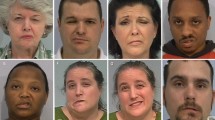Abstract
Hemifacial spasm (HFS) is a common neurological disorder characterized by involuntary tonic and clonic contractions of the muscles innervated by the facial nerve. We aimed to describe clinical features, common antecedents, triggers and relieving factors in patients with hemifacial spasm to study the correlation of hypertension and HFS, and to compare clinical features of primary and secondary cases of HFS. The data for the study were collected prospectively on a predesigned and pre-tested format at the first attendance in all consecutive HFS patients attending the movement disorders clinic of a tertiary teaching hospital in India. The demographic profile, HFS symptoms, antecedent illnesses and neurological examination were recorded and analyzed. Muscle power in individual muscles innervated by the facial nerve was tested carefully before botulinum toxin injection. Hemifacial spasm occurred in 7.14% (n = 582) of 8,151 cases registered at the movement disorders clinic from 1993 to 2010. Data of 321 patients were complete and were included in the study. Females constituted 49.22% (n = 158). The mean age the patients was 46.02 ± 11.82 years; ipsilateral ear clicking was observed in 22.74% cases. The most common aggravating factor was stress (44.86%), while the most common relieving factor was sleep (44.24%). Two hundred fifty-two patients (78.5%) had primary HFS. The severity of spasm correlated significantly with disease duration (p < 0.001) and weakness of facial muscles (p < 0.001). We did not observe any correlation between HFS on the left side and hypertension, as has been reported earlier. This is one of the largest studies of HFS patients and the only one that prospectively assesses patients with HFS clinically on their first visit. Interesting observations of this study are lack of female preponderance, presence of clicking in the ipsilateral ear and facial weakness even prior to botulinum toxin injection.
Similar content being viewed by others
References
Møller AR (1987) Hemifacial spasm: ephaptic transmission or hyperexcitability of the facial motor nucleus? Exp Neurol 98:110–119
Møller AR (1993) Cranial nerve dysfunction syndromes: pathophysiology of microvascular compression. In: Barrow DL (ed) surgery of cranial nerves of the posterior fossa. Neurosurgical topics book 13, American Association of Neurological Surgeons: Park Ridge. IL pp 105–129
Møller AR (1999) Pathophysiology of hemifacial spasm. In: Sinha KK, Chandra P (eds) Advances in clinical neurosciences. Ranchi, India, pp 125–139
Wilkinson MF, Kaufmann AM (2005) Monitoring of facial muscle motor evoked potentials during microvascular decompression for hemifacial spasm: evidence of changes in motor neuron excitability. J Neurosurg 103(1):64–69
Krishnan AV, Hayes M, Kiernan MC (2007) Axonal excitability properties in hemifacial spasm. Mov Disord 22:1293–1298
Nielsen VK (1984) Pathophysiology of hemifacial spasm I: ephaptic transmission and ectopic excitation. Neurology 34:418–426
Jannetta PJ, Segal R, Wolfson SK Jr (1985) Neurogenic hypertension: etiology and surgical treatment. I: observations in 53 patients. Ann Surg 201:391–398
Auger RG, Whisnant JP (1990) Hemifacial spasm in Rochester and Olmstead County, Minnesota, 1960 to 1984. Arch Neurol 47:1233–1234
Wu Y, Davidson AL, Pan T, Jankovic J (2010) Asian over-representation among patients with hemifacial spasm compared to patients with cranial–cervical dystonia. J Neurol Sci 298(1–2):61–63
Felicio AC, Godeiro-Junior Cde O, Borges V, Silva SM, Ferraz HB (2007) Clinical assessment of patients with primary and post paralytic hemifacial spasm: a retrospective study. Arq Neuropsiquiatr 65(3B):783–786
Colosimo C, Bologna M, Lamberti S, Avanzino L, Marinelli L, Fabbrini G et al (2006) A comparative study of primary and secondary hemifacial spasm. Arch Neurol 63(3):441–444
Møller MB, Møller AR (1985) Audiometric abnormalities in hemifacial spasm. Audiology 24:396–405
Behari M, Srivastava AK, Das RR, Pandey RM (2001) Risk factors of Parkinson’s disease in Indian patients. J Neurol Sci 190(1–2):49–55
Defazio G, Berardelli A, Abbruzzese G et al (2000) Primary hemifacial spasm and arterial hypertension: a multicenter case—control study. Neurology 54:1198–1200
Stamey W, Jankovic J (2007) The other Babinski sign in hemifacial spasm. Neurology 69(4):402–404
Jenny AB, Saper CB (1987) Organization of the facial nucleus and corticofacial projection in the monkey: a reconsideration of the upper motor neuron facial palsy. Neurology 37(6):930–939
Naraghi R, Tanrikulu L, Troescher-Weber R, Bischoff B, Hecht M, Buchfelder M, Hastreiter P (2007) Classification of neurovascular compression in typical hemifacial spasm: three-dimensional visualization of the facial and the vestibulocochlear nerves. J Neurosurg 107(6):1154–1163
Yurtseven T, Savaş R, Koçak A, Turhan T, Aktaş EO, Işlekel S (2004) Relationship between anterior inferior cerebellar artery and facial-vestibulocochlear nerve complex: an anatomical and magnetic resonance images correlation study. Minim Invasive Neurosurg 47(5):306–311
Jannetta PJ (1975) The cause of hemifacial spasm-definitive microsurgical treatment at the brainstem in 31 patients. Trans Sect Otolaryngol Am Acad Ophthalmol Otolaryngol 80(3 Pt 1):319–322
Campbell WW (2005) DeJong’s the neurologic examination, 6th edn. Lippincott williams and wilkins, Baltimore, p 224
Gowers WR (1898) Facial nerve. In: a manual of diseases of the nervous system, vol II. pp 254
Acknowledgments
The authors acknowledge with thanks the statistical analysis and help by Ms. M. Kalaivani, M.Sc. (Biostatistics), Department of Biostatistics, and residents of the Department of Neurology, who collected patient data at the All India Institute of Medical Sciences, New Delhi, India.
Conflicts of interest
None.
Author information
Authors and Affiliations
Corresponding author
Rights and permissions
About this article
Cite this article
Batla, A., Goyal, C., Shukla, G. et al. Hemifacial spasm: clinical characteristics of 321 Indian patients. J Neurol 259, 1561–1565 (2012). https://doi.org/10.1007/s00415-011-6376-3
Received:
Revised:
Accepted:
Published:
Issue Date:
DOI: https://doi.org/10.1007/s00415-011-6376-3




